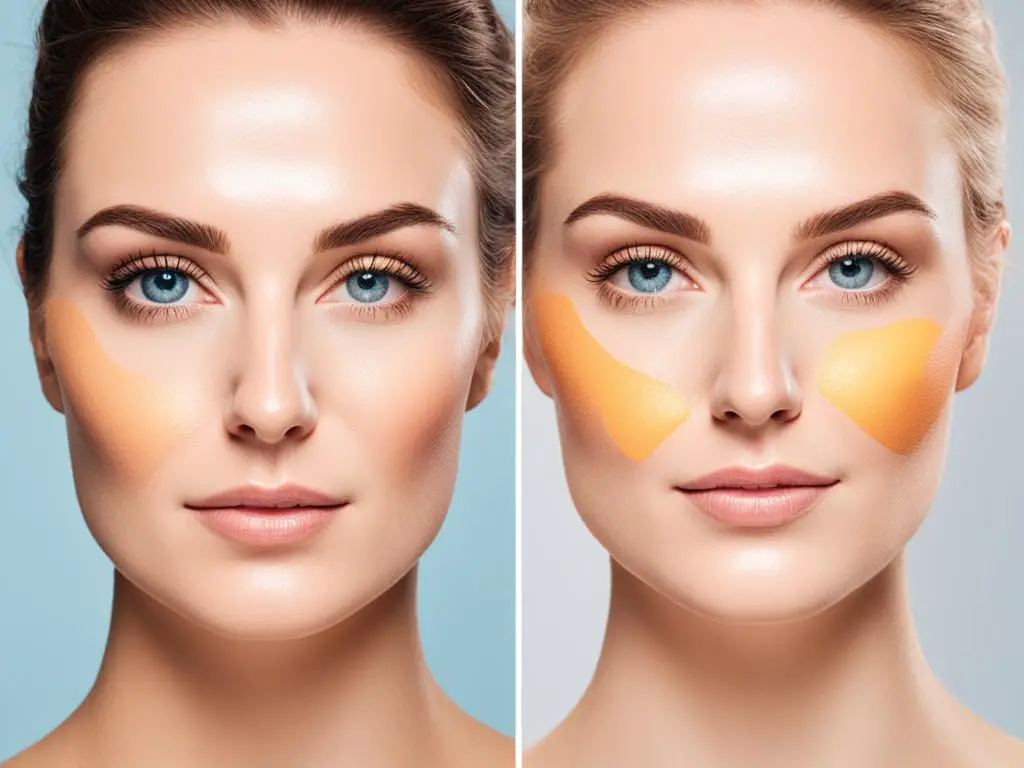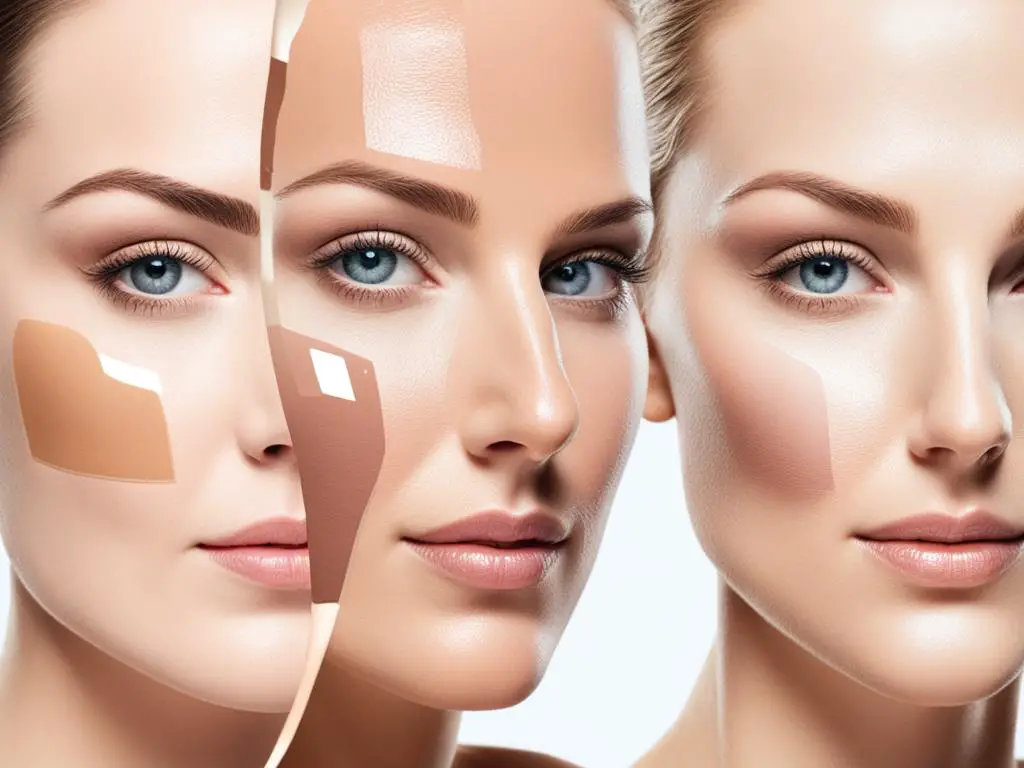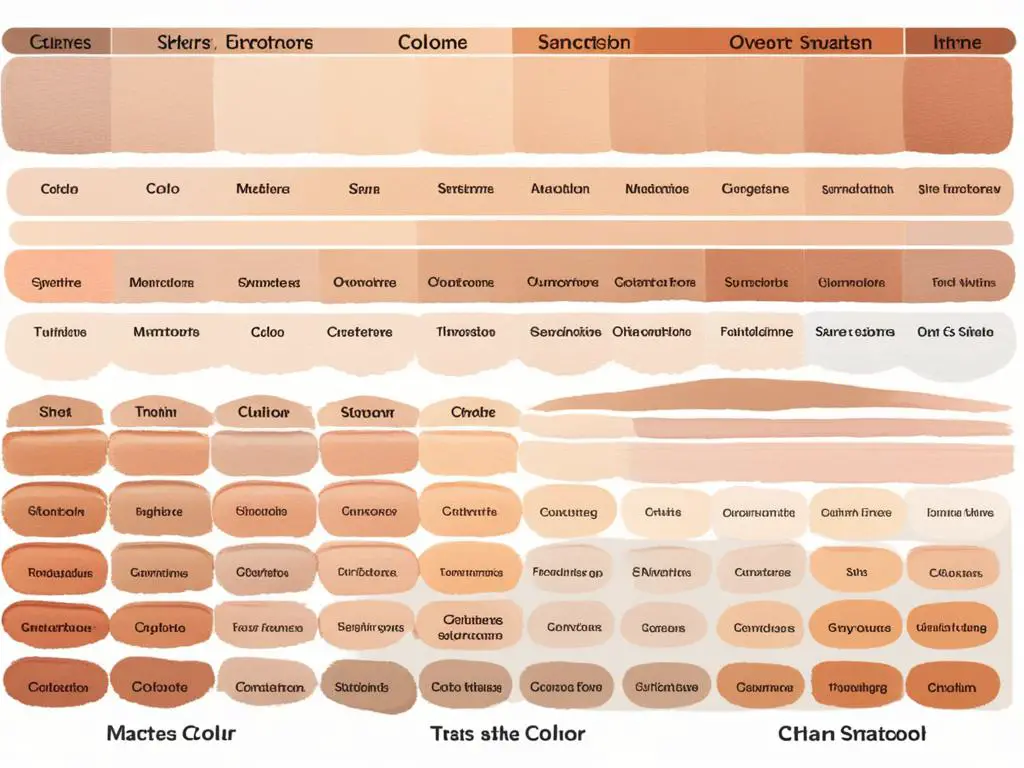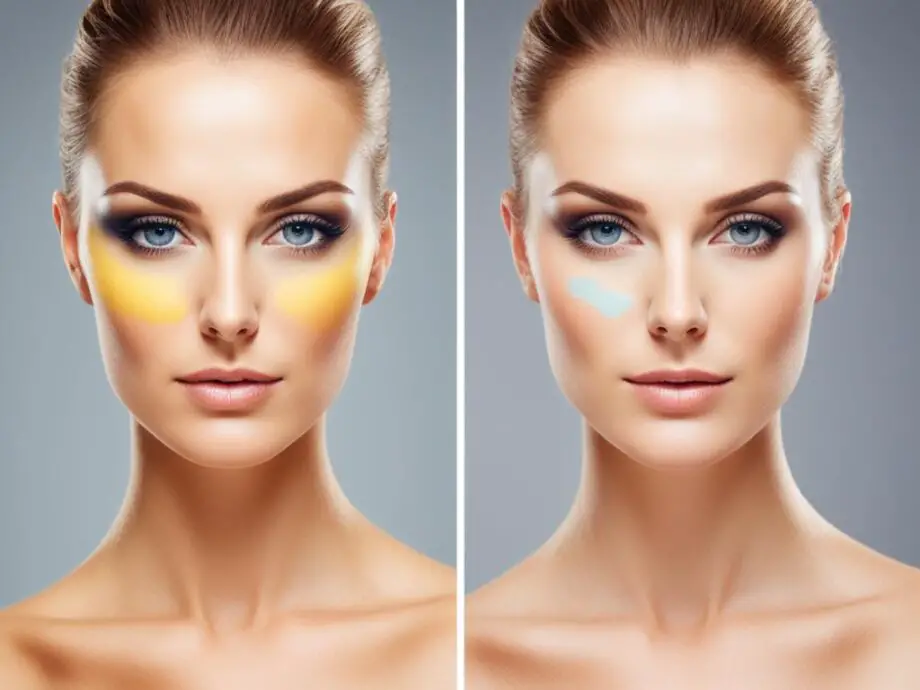Welcome to our comprehensive guide on understanding overtone and undertone skin! Determining your skin’s undertone is crucial in finding the right foundation shade that enhances your natural beauty. In this article, we’ll explore the differences between overtone and undertone skin and provide you with practical methods to identify your specific undertone. Let’s dive in!
Key Takeaways:
- Understanding the distinction between overtone and undertone is essential in selecting makeup that complements your complexion.
- There are various methods to determine your undertone, including the vein test, jewelry test, and clothing test.
- Once you know your undertone, you can easily match your foundation to create a seamless extension of your natural skin.
- Enhancing your undertone through makeup, hair color, and clothing choices can elevate your overall appearance.
- Troubleshooting common matching issues, such as mismatched undertones, will help you achieve a flawless foundation application.
Understanding Overtone and Undertone Skin
When it comes to your skin, there are two important aspects to consider: overtone and undertone. While overtone refers to the surface color of your skin, undertone represents the underlying hue that remains consistent and unaffected by factors like sun exposure.
Understanding the difference between overtone and undertone is crucial in selecting makeup that complements your unique complexion. Let’s dive deeper into each of these skin characteristics:
Overtone: Your Skin’s Surface Color
Your overtone is what you generally perceive as your skin color. It can range from fair to medium to deep tones. When determining your overtone, factors such as sun exposure, lifestyle, and even temporary changes due to seasonal shifts can come into play. However, it’s important to note that overtone can change over time.
Undertone: The Underlying Hue
Unlike overtone, your undertone remains relatively constant and doesn’t change based on external factors like sun exposure. It is the subtle hue underneath your skin’s surface and plays a significant role in determining which makeup shades look best on you.
Your undertone is like the unseen foundation that lies beneath your overtone. It’s essential to understand and embrace your undertone to make informed decisions when choosing foundation shades and other makeup products.
Now that you know the difference between overtone and undertone, you can confidently navigate the world of makeup and choose products that enhance your natural beauty. Determining your undertone will help you find the perfect foundation shade, allowing you to achieve a harmonious and seamless look.
| Overtone | Undertone |
|---|---|
| Surface color of the skin | Underlying hue that remains constant |
| Can be influenced by factors like sun exposure | Not affected by external factors like sun exposure |
| Overtone may change over time | Undertone remains relatively constant |

Identifying Your Undertone
When it comes to determining your undertone, there are several methods you can use. By analyzing your skin’s undertone, you can gain a better understanding of which foundation shades will suit you best. Let’s explore some of these undertone detection techniques below.
The Vein Test
The vein test is a simple and popular method for identifying your undertone. Look at the veins on the underside of your wrist or forearm. If they appear blue or purple, you likely have a cool undertone. If they have a greenish tint, your undertone is warm. For individuals with a mix of both blue and green veins, you may have a neutral undertone.
The Jewelry Test
The jewelry test involves considering how different types of metals and jewelry look on your skin. Those with cool undertones tend to look best in silver jewelry, while warm undertones often complement gold. If both metals suit you equally well, you may have a neutral undertone.
The Clothing Test
Another way to analyze your undertone is by assessing how different-colored clothing flatters your complexion. Cool undertones typically look good in shades of blue, purple, and gray, while warm undertones are enhanced by earthy tones like olive, yellow, and orange. Neutral undertones tend to suit a wide range of colors without any particular shade overpowering the complexion.
By utilizing these undertone detection methods, you can uncover the secret to finding the perfect foundation shade that harmonizes with your natural skin tone.

| Undertone | Vein Color | Jewelry Preference | Clothing Colors |
|---|---|---|---|
| Cool | Blue or purple | Silver | Blue, purple, gray |
| Warm | Greenish | Gold | Olive, yellow, orange |
| Neutral | Both blue and green | Silver and gold | A wide range of colors |
Matching Your Foundation to Your Undertone
Once you have identified your undertone, the next step in finding your perfect foundation shade is matching it to your undertone. By selecting a foundation that complements your undertone, you can achieve a seamless and natural look that enhances your skin tone.
Here are some tips to help you find the right foundation for your undertone:
1. Determine Your Undertone
- Warm Undertone: If your skin has a golden, peachy, or yellow hue, you likely have a warm undertone.
- Cool Undertone: If your skin has a pink, red, or bluish hue, you likely have a cool undertone.
- Neutral Undertone: If your skin has a mix of warm and cool hues or a beige hue, you likely have a neutral undertone.
2. Choose the Right Foundation Formula
Consider your skin type and choose a foundation formula that suits your needs. For dry skin, opt for a hydrating or moisturizing foundation. If you have oily skin, look for a mattifying or oil-free foundation. Combination skin can benefit from a lightweight and breathable foundation.
3. Test Multiple Shades
When trying to match your foundation shade, it’s essential to test multiple shades on your jawline or wrist. Choose a few shades that closely match your undertone, and swatch them side by side. The one that disappears seamlessly into your skin is the right match.
“Finding the perfect foundation shade is like finding a second skin – it should blend effortlessly and enhance your natural beauty.” – Beauty Expert
Remember, lighting conditions can affect how a foundation shade appears on your skin. Try to test the shades in natural light to get the most accurate representation.
4. Consider Undertone Adjusters
If you have difficulty finding a foundation shade that matches your undertone exactly, consider using undertone adjusters. These products can help warm up or cool down a foundation shade, allowing you to customize it to your undertone.

By following these tips, you’ll be on your way to finding a foundation shade that seamlessly blends with your undertone, giving you a flawless and natural-looking complexion.
Enhancing Your Undertone
Understanding your undertone is not only essential for finding the right foundation shade but also for enhancing your natural features. By utilizing makeup techniques, choosing hair colors, and selecting clothing that complements your undertone, you can accentuate your unique beauty.
Makeup Application
When it comes to makeup, certain shades can enhance warm or cool undertones. For individuals with warm undertones, earthy tones such as warm browns, peachy pinks, and golden hues can help bring out the warmth in their complexion. On the other hand, individuals with cool undertones can opt for cooler shades like rosy pinks, icy blues, and silver-based colors to enhance their natural coolness.
Pro Tip: A trick to determining whether a particular shade will complement your undertone is to swatch it on your wrist or the side of your face. If it harmonizes with your skin, it’s likely to be a good match.
Playing with Hair Color
Your undertone can also influence the hair color that suits you best. Warm undertones tend to complement hair colors like golden blondes, caramel browns, and rich chocolate shades. On the other hand, cool undertones can rock ash blondes, platinum blondes, cool browns, or black shades. Experimenting with different hair colors that align with your undertone can help create a cohesive and harmonious look.
Clothing Choices
Your clothing choices can make a significant impact on enhancing your undertone. Individuals with warm undertones can gravitate towards clothing in earthy tones, such as oranges, yellows, and warm greens. On the other hand, those with cool undertones can opt for colors like blues, purples, and cool greens to accentuate their undertone. Additionally, understanding how different shades of neutrals complement your undertone can help you create versatile and stylish outfits that highlight your natural beauty.
By employing these tips and tricks, you can confidently enhance your undertone and create a cohesive and flattering look. Remember, understanding your undertone allows you to embrace your unique features and showcase your natural beauty.
Troubleshooting Common Matching Issues
While finding the perfect foundation match can be a challenge, don’t fret! In this section, we’ll address common issues that arise when trying to find a foundation that matches your undertone. Let’s dive in and resolve these problems together.
Mismatched Undertones
One common issue is ending up with a foundation shade that doesn’t match your undertone. This can result in a noticeable contrast between your face and neck, making your makeup look unnatural. To avoid this, it’s essential to accurately analyze your skin tone and undertone.
To analyze your skin tone, start by determining whether you have a warm, cool, or neutral undertone. There are various methods to help you identify your undertone, such as:
- The vein test: Check the color of your veins on your wrist or forearm. Blue or purple veins indicate a cool undertone, while green veins suggest a warm undertone. If you can’t clearly determine the color, you may have a neutral undertone.
- The jewelry test: Consider whether gold or silver jewelry looks better on you. If gold complements your skin, you likely have a warm undertone. If silver looks more flattering, you probably have a cool undertone.
- The clothing test: Pay attention to how different colors of clothing make your skin appear. If warm colors (like red, orange, or yellow) enhance your complexion, you likely have a warm undertone. If cool shades (such as blue, purple, or green) make your skin glow, you probably have a cool undertone.
By identifying your undertone through these tests, you can avoid choosing foundations with mismatched undertones, ensuring a seamless and natural-looking finish.
Dealing with Unnatural-Looking Makeup
Another common issue is ending up with makeup that looks unnatural on your skin. This can be due to several factors, including using a foundation shade that is too light or too dark, or not considering your undertone when selecting other makeup products.
To address this problem, make sure to:
- Choose a foundation shade that closely matches your undertone. Consider the undertones of your skin, such as whether it leans warm, cool, or neutral.
- Test the foundation on your jawline or the side of your face to ensure it seamlessly blends with your natural skin tone and disappears into your skin.
- Pay attention to other makeup products, such as blush, bronzer, and lipstick. Ensure these products also complement your undertone to achieve a cohesive and harmonious look.
Remember, the goal is to enhance your natural features, so selecting makeup shades that align with your undertone is key.
Changes in Undertone due to Sun Exposure or Aging
Over time, your skin undertone may change due to factors such as sun exposure or the natural aging process. This can pose a challenge when it comes to finding the right foundation shade.
If you experience changes in your undertone, consider the following tips:
- Reassess your skin undertone periodically to ensure you’re using the correct foundation shade. Your undertone may shift, especially if you’ve spent a lot of time in the sun or as you age.
- Consult with a makeup professional or beauty advisor who can help you select a foundation shade that suits your current undertone.
- Consider using color-adjusting foundation products that adapt to your skin tone. These innovative formulas can help you achieve a more accurate match, even if your undertone fluctuates.
By addressing these common matching issues and following the tips mentioned, you can confidently find the right foundation for your undertone, ensuring a flawless and natural-looking finish.
Conclusion
Understanding the difference between overtone and undertone skin is crucial when it comes to selecting the right foundation shade and enhancing your natural beauty. By following our expert tips and techniques, you can confidently identify your undertone and find the perfect foundation match that seamlessly blends with your complexion.
Knowing your undertone allows you to make informed choices in makeup application, hair color, and clothing, ultimately enhancing your overall appearance. It is the key to achieving a harmonious and flawless look that complements your unique features.
Through the process of skin color assessment and undertone detection, you can unlock a world of possibilities in self-expression and self-confidence. Whether you have a warm, cool, or neutral undertone, our guide has provided you with the tools to navigate the world of beauty with ease and grace.
